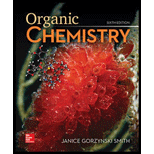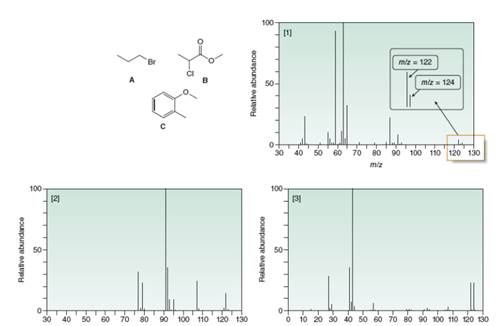
Study Guide/solutions Manual For Organic Chemistry
6th Edition
ISBN: 9781260475678
Author: Janice Gorzynski Smith Dr.
Publisher: McGraw-Hill Education
expand_more
expand_more
format_list_bulleted
Concept explainers
Textbook Question
Chapter 12A, Problem 22P
Match each structure to its mass spectrum

Expert Solution & Answer
Want to see the full answer?
Check out a sample textbook solution
Students have asked these similar questions
16. Complete the following chart
Chemical
Compound
BF3
NC13
PC15
VSEPR Drawing
Name of VSEPR Shape
Presence of Dipole
(Yes or No)
Steps and detailed explanation for work. Thanks!
Steps and detailed explanation for work. Thanks!
Chapter 12A Solutions
Study Guide/solutions Manual For Organic Chemistry
Ch. 12A.1 - What is the mass of the molecular ion formed from...Ch. 12A.1 - Prob. 3PCh. 12A.2 - Prob. 6PCh. 12A.2 - What molecular ions would you expect for the...Ch. 12A.3 - The mass spectrum of 2,3-dimethylpentane also...Ch. 12A.3 - The base peak in the mass spectrum of 2, 2,...Ch. 12A - Problem-13.24 The mass spectrum of the following...Ch. 12A - Prob. 16PCh. 12A - Which compound gives a molecular ion at m/z= 122,...Ch. 12A - Propose two molecular formulas for each molecular...
Ch. 12A - Propose four possible structures for a hydrocarbon...Ch. 12A - Problem-13.29 What is the molecular formula for...Ch. 12A - Problem-13.30 Propose a molecular formula for rose...Ch. 12A - 13.31 Match each structure to its mass spectrum
Ch. 12A - 13.32 Propose two possible structures for a...
Additional Science Textbook Solutions
Find more solutions based on key concepts
How does the removal of hydrogen atoms from nutrient molecules result in a loss of energy from the nutrient mol...
SEELEY'S ANATOMY+PHYSIOLOGY
Separate the list P,F,V,,T,a,m,L,t, and V into intensive properties, extensive properties, and nonproperties.
Fundamentals Of Thermodynamics
2. Why is it that the range of resting blood pressures of humans is best represented by a bell-shaped curve co...
Human Biology: Concepts and Current Issues (8th Edition)
Give the IUPAC name for each compound.
Organic Chemistry
What were the major microbiological interests of Martinus Beijerinck and Sergei Winogradsky? It can be said tha...
Brock Biology of Microorganisms (15th Edition)
How could you separate a mixture of the following compounds? The reagents available to you are water, either, 1...
Organic Chemistry (8th Edition)
Knowledge Booster
Learn more about
Need a deep-dive on the concept behind this application? Look no further. Learn more about this topic, chemistry and related others by exploring similar questions and additional content below.Similar questions
- Please correct answer and don't used hand raitingarrow_forwardhello, this is about physical chemistry . can you help me please?arrow_forwardPROBLEM 5+ What is the major product of each of the following reactions? a. CH3CH2CHCH3 + HBr d. + HBr A OH OH CH3 CH3 e. b. -OH + HCI + HCl A, OH CH3 OH CH3 c. CH3C CHCH3 + HBr CH3 OH f. CHCH3 + HCl ^>arrow_forward
- One suggestion for solving the fuel shortage due to decreasing volumes of fossil fuels are hydrogen / oxygen fuel cells. a. State the two half-cell reaction equations for such fuel cells. Calculate the cell potential as well as the electrical work gained by this fuel cell at standard conditions with E002/H20 = 1.229 V. b. Compare the fuel cell to the Gibbs free energy of the combustion reaction of n-octane at standard conditions. Use ASºm, n-Oct., 1 = 361.2 J/mol K.arrow_forwarda. Determine the electrochemical potential of the following cell using E°Mg2+/Mg = -2.362 V. Mg | Mg2+ (a=104) || H* (a = 4) | H2 (p = 0.5 bar) | Pt b. A galvanic chain consists of Co²+ / Co and Ag+ / Ag half-cells with EºCo²+/Co = -0.282 V and Eº Ag+/Ag = 0.799 V. Determine which half-cell will be reduced and which one will be oxidised. Furthermore, calculate the electrochemical potential as well as the equilibrium constant of the whole cell at i. [Co²+] = 0.1 M and [Ag+] = 0.5 M ii. [Co²+] = 0.001 M and [Ag*] = 1.5 Marrow_forwardThe equilibrium voltage of the following cell has been measured at 0.522 V at 25 °C. Pt | H2, g❘ HClaq || AgClaq | Ags State the redox reactions present in this cell. Calculate the pH value of the electrolyte solution with KL, AgCl = 1.96 · 10-10 mol² / L². Assume that the concentrations of H+ and Clare equal.arrow_forward
- Here are the energies (in kcal/mol) for staggered and eclipsed interactions for CH, CC, and CBr bonds eclipsed (0°) staggered (60°) bonds CH/CH 1.0 0.0 CH/CC 1.3 0.0 Br: CC/CC 3.0 0.9 Br CH/CBr 1.8 0.0 CC / CBr 3.3 1.0 CBr / CBr 3.7 1.2 a) I've drawn the Newman projection for one of the staggered conformations of the molecule above, looking down the C2-C3 bond. Draw Newman projections for the other two staggered and the three eclipsed conformations (in order). CH₂ H3C. H' H Br b) Calculate the relative energies for each of the conformations and write them below each conformation.arrow_forward90. Draw the stereoisomers obtained from each of the following reactions: a. H₂ b. H₂ C. H₂ Pd/C Pd/C Pd/Carrow_forward36. The emission spectrum below for a one-electron (hydrogen-like) species in the gas phase shows all the lines, before they merge together, resulting from transitions to the first excited state from higher energy states. Line A has a wavelength of 434 nm. BA Increasing wavelength, λ (a) What are the upper and lower principal quantum numbers corresponding to the lines labeled A and B? (b) Identify the one-electron species that exhibits the spectrum.arrow_forward
- f) The unusual molecule [2.2.2] propellane is pictured. 1) Given the bond length and bond angles in the image, what hybridization scheme best describes the carbons marked by the askerisks? 2) What types of orbitals are used in the bond between the two carbons marked by the askerisks? 3) How does this bond compare to an ordinary carbon-carbon bond (which is usually 1.54 Å long)? H₂C H₂C CH2 1.60Å ハ C. * CH₂ H₂C * C H₂ 120°arrow_forwardQuestion Resonance Forms a) Draw all resonance forms of the molecules. Include curved arrow notation. Label major resonance contributor Resonance Forms a) Draw all resonance forms of the molecules. Include curved arrow notation. Label major resonance contributorarrow_forwardCan you show me or determine the longest carbon chain, which is octane? Potentially highlight it in different sections to show me, plz, or individually?arrow_forward
arrow_back_ios
SEE MORE QUESTIONS
arrow_forward_ios
Recommended textbooks for you
 General Chemistry - Standalone book (MindTap Cour...ChemistryISBN:9781305580343Author:Steven D. Gammon, Ebbing, Darrell Ebbing, Steven D., Darrell; Gammon, Darrell Ebbing; Steven D. Gammon, Darrell D.; Gammon, Ebbing; Steven D. Gammon; DarrellPublisher:Cengage Learning
General Chemistry - Standalone book (MindTap Cour...ChemistryISBN:9781305580343Author:Steven D. Gammon, Ebbing, Darrell Ebbing, Steven D., Darrell; Gammon, Darrell Ebbing; Steven D. Gammon, Darrell D.; Gammon, Ebbing; Steven D. Gammon; DarrellPublisher:Cengage Learning Organic Chemistry: A Guided InquiryChemistryISBN:9780618974122Author:Andrei StraumanisPublisher:Cengage Learning
Organic Chemistry: A Guided InquiryChemistryISBN:9780618974122Author:Andrei StraumanisPublisher:Cengage Learning

General Chemistry - Standalone book (MindTap Cour...
Chemistry
ISBN:9781305580343
Author:Steven D. Gammon, Ebbing, Darrell Ebbing, Steven D., Darrell; Gammon, Darrell Ebbing; Steven D. Gammon, Darrell D.; Gammon, Ebbing; Steven D. Gammon; Darrell
Publisher:Cengage Learning

Organic Chemistry: A Guided Inquiry
Chemistry
ISBN:9780618974122
Author:Andrei Straumanis
Publisher:Cengage Learning


Mass Spectrometry; Author: Professor Dave Explains;https://www.youtube.com/watch?v=hSirWciIvSg;License: Standard YouTube License, CC-BY